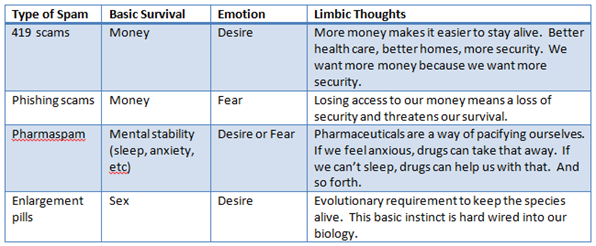The Psychology of Spamming, part 4 - Why we fall for scams
Impact
We humans had Stone Age ancestors for a long time and our limbic systems kept us alive; when we feel afraid of something, say snakes, it is because our brains are hard wired to avoid things that could harm us. The fear response is actually a good thing. However, eventually our neocortexes evolved. When they did, civilization advanced. Unfortunately, our limbic system was ill-prepared to deal with all of the change. There is a mismatch between the evolutionary adaptiveness of emotions and the environments in which we make decisions.
We used to eat in order to survive, and survival was difficult. Now, we have all sorts of temptations like chocolate, fatty fried foods, excess sugar, and the like. Our brains tell us that food is good and we need it to survive, and our emotions of desire tell us that it will taste good. Similarly, back in the Stone Age, and when we were still prior to the missing link, species had to engage in sexual behavior in order to keep the species alive. Sexual desire is built into our brains because it was a survival necessity. Yet now, the population is not in any need of propagation. Better nutrition and medical advances has prolonged our lives, but the desire for sexual contact is still there (and has to remain there otherwise we’d all disappear within a generation). Our limbic systems have not caught up to the scope of change, and we, as a civilization, are in future shock.
Unfortunately, this scope of technological change which has introduced future shock has also resulted in malicious actors being able to exploit the rest of us for nefarious purposes.
Spamming
The availability of technology in modern society has enabled scammers to move to a new platform. I say “scammers” and not “spammers” because scams have been around for a very long time. Our Stone Age brains are still hard wired to protect us and alleviate the fear response. However, when we see something that we trust and are given a way to protect ourselves from harm, we haven’t adapted yet to automatically think about the possibility someone might be attempting to deceive us.
These scams work because of the following:
- They speak to our limbic brain that drives our basic biological instincts required to survive
- They use techniques such as time urgency, control, and serious impact associated with doing or ignoring them
- They invoke positive or negative affect which has been demonstrated to influence people’s decisions
The advantage of email is that it is cheap and the sender does not bear the cost of processing it. If the receiver had to pay for postage, then scammers would have been doing the same thing as soon as the US Postal Service was created. If only 1 in 10,000 phishing scams worked on its victims, and if the average theft from a phishing scam is $900[1], then to make a respectable gross wage of $50,000 a spammer only need to send out half a million spams. Spam filters make delivery more difficult, and so a spammer would need to send at least 10 times that amount, say 50 million spam messages. However, as the cost of technology has fallen, the regrettable by-product is that 50 million is a small amount of emails to send over the course of a year.
Our Stone Age brains have not yet caught up to the reality of malicious intent, particularly with technology.
Part 1 - How our brains work
Part 2 - The Limbic system, cognition and affect
Part 3 - External factors that influence our decisions
Part 4 - Why we fall for scams
Parr 5 - Solutions
Part 6 - The Flynn Effect
[1] Technically $886 according to Gartner in 2007, https://www.gartner.com/it/page.jsp?id=565125. Consumer Reports claimed it was $395 per incident in 2005, see https://www.hancockbank.com/personal/per\_identity/per\_identity\_phish.asp
